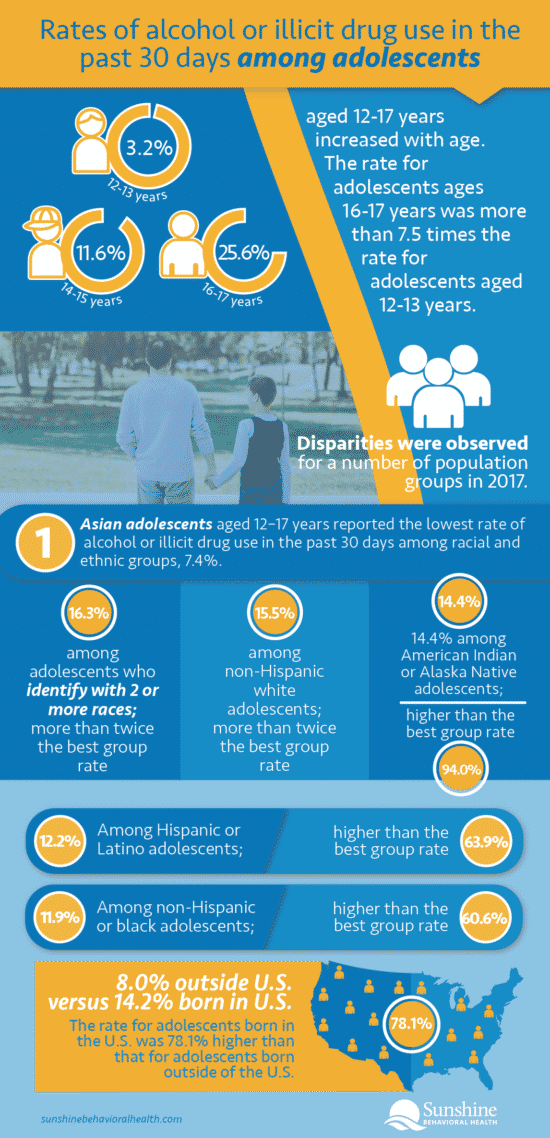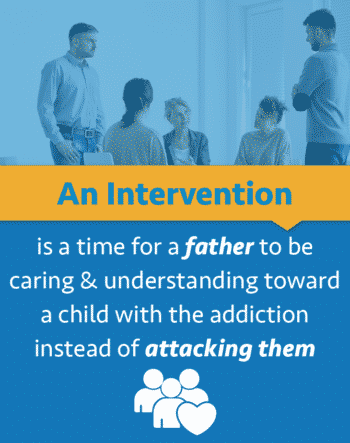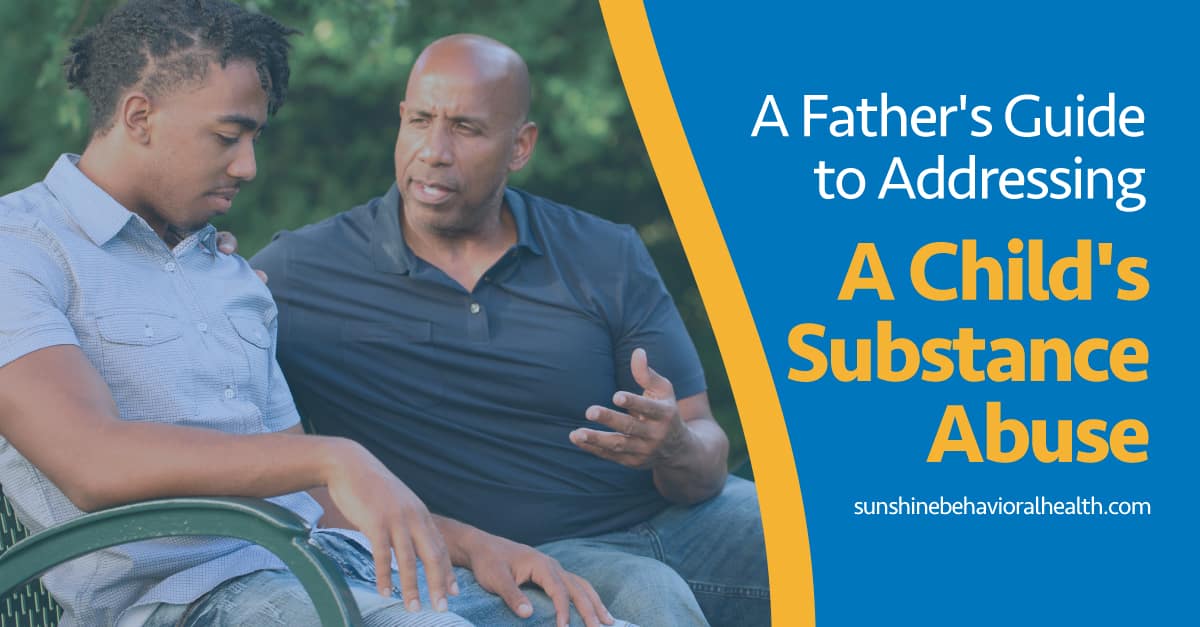In many cases, it’s a loved one who seeks help for a person who’s experiencing substance use disorder. Fathers might see that they’re children are struggling with substance use disorder problems and want to address them.
Given the statistics, many fathers might be facing such problems. Data from the 2019 National Survey on Drug Use and Health (NSDUH) of the Substance Use Disorder and Mental Health Services Administration (SAMHSA) reported that there were 18.9 million Americans aged 12 or older who had a substance use disorder in the past year but did not receive treatment at a specialty facility. Of this group, 95.7 percent didn’t think they needed treatment for the problem.
Large numbers of people have substance use disorders, yet are not receiving treatment and do not feel they need it. The actual numbers may be even higher, as additional people might have been experiencing substance use disorder yet didn’t receive a diagnosis or weren’t included in the survey.
Researchers found that 4.3 percent of the people who responded to the 2019 NSDUH felt they needed treatment but did not receive it:
- 39.9 percent didn’t feel ready to stop using drugs or alcohol.
- 23.8 percent were uncertain where to seek treatment.
- 20.9 percent didn’t think they could afford treatment.
When children who are abusing substances fail to seek treatment or even recognize their problems, loved ones like their fathers might step in to address their behaviors and encourage treatment.
Signs and Symptoms of a Child’s Substance Use
As is evident by the NSDUH data, people facing substance use disorder do not always realize their problems or seek treatment. This is understandable behavior when we consider the nature of a substance use disorder.
Through continued use, a person could become tolerant and need higher amounts of alcohol or a drug to achieve the same effects they once experienced. This can lead to dependence and symptoms of withdrawal if the person abruptly tries to reduce or quit using drugs or alcohol.
Substance use disorder is also characterized by focusing large amounts of attention on having and using a substance, feeling cravings to use it, feeling the need to use it continuously, and using more than intended.
People with a substance use disorder may engage in behaviors related to the substance use, such as
- Neglecting responsibilities, people, and hobbies that were once important.
- Experiencing financial and legal trouble.
- Lying, stealing, or participating in other illegal activities to obtain the substance.
- Engaging in risky behaviors while under the influence of alcohol or drugs.
A person may try to stop using substances but feel unable or unwilling to do so.
Another common marker of substance use disorder is continuing to use the substance despite the many problems it causes or contributes to in the person’s life.
These signs and behaviors show how a person becomes ensnared in substance use. Their body and mind become dependent and their thinking and behaviors change because of the substance. These characteristics make it difficult to overcome the substance use or even fully realize the extent of the problem.
Yet family members, friends and others may notice the impact the substance use is having on the person and the lives of their loved ones. While a person’s viewpoint may be distorted by substance use, a father may have a more objective viewpoint on the situation.
They may be able to observe behaviors and tell the child what they notice. Also, fathers and other loved ones are often personally affected by a loved one’s substance use.
Addiction-related behaviors and problems often affect the lives of others. For example, people with addictions might stop seeing loved ones, steal money and lie, act differently when under the influence, and need help solving financial and legal problems.
Fathers of children with addictions are often personally affected by these behaviors and others. They might encourage their children to receive help out of a desire to see their children heal and to stop the impact the child’s behaviors are having on others.

Steps a Father Can Take for an Addicted Child
Instead of using ultimatums, threats, punishments or other negative interactions, a father can help a child by providing love and support.
Fathers have tools at their disposal for addressing their children’s substance use and abuse. The steps they take may vary based on the dynamics of the situations and their relationships.
Also, the age of the children and whether the children are living in their fathers’ homes may determine the fathers’ tactics. Fathers may need to take different approaches for underage children living with them compared to adult children living on their own.
Children will also need to take personal responsibility and work to overcome substance use disorder problems. Fathers who are eager help will only be able to do so much. Therefore, fathers might be focused on encouraging and convincing children to recognize their problems and seek help.
One way a father can help his child is by learning as much as possible about substance use disorder, including symptoms and treatment methods. He can also discuss the situation with addiction treatment professionals to learn more and understand how best to address his child’s substance use.
A father might be able to help by:
Having a Talk
 A smart first step is to have a serious talk with a child. A father should pick a time and place with minimal distractions and ask the child to devote the time and attention to a discussion. The father may want to start with a private, one-on-one talk with their child. To help the child understand what’s happening, a father should try to pick a meeting time when he thinks his child will be sober.
A smart first step is to have a serious talk with a child. A father should pick a time and place with minimal distractions and ask the child to devote the time and attention to a discussion. The father may want to start with a private, one-on-one talk with their child. To help the child understand what’s happening, a father should try to pick a meeting time when he thinks his child will be sober.
It’s important for the father to set a caring, compassionate, and nonjudgmental tone for the meeting. Instead of making accusations and attacking a child, he should try to calmly discuss the behaviors he has noticed. He can express that he and other loved ones are concerned about the behaviors and discuss the problems the substance use has been causing.
During the conversation, the father should be prepared to receive some resistance, such as defensiveness, denial, or anger. These responses are normal, so the father should aim to be understanding and try to continue with the talk. It may be necessary to have patience, give a child space, and return to the discussion at a later time.
In the talk, it’s a good idea to allow the child to express himself or or herself. Otherwise, it may feel as if the father is attacking or making decisions for his child. To encourage conversation, a father may want to:
- Ask the child why they started using the substance and are continuing to use it.
- Listen and try to understand the child’s feelings and experiences.
- Express the desire to provide support and come up with a solution.
- Talk with their child about treatment options and barriers that might be preventing such treatment. Consider the reasons someone may not seek help. Does the child think that they don’t need help? Do they think the family can’t afford treatment? Do they not know how or where to find treatment? Try to recognize the full extent of the child’s problem to understand the best ways to approach them.
- Research treatment options for the child. Consider the programs that could fit the child’s needs. There are specialized programs for teens, for addictions to certain substances, for those with a co-occurring mental health condition, and for other considerations. There are inpatient programs that remove people from their environments to help them focus on recovery as well as outpatient programs that provide treatment while people fulfill school or work responsibilities. The father may want to seek professional guidance in researching and choosing a program.
Staging an Intervention or Participating in Family Training
A father may decide to try stage an intervention. An intervention is a meeting that brings a group of loved ones together to talk with a person with an addiction.
Once again, an intervention is a time for a father to be caring and understanding toward a child with the addiction instead of attacking them. When loved ones decide to perform an intervention, it is helpful to enlist the assistance of an addiction professional trained in interventions. This type of professional can guide the conversation and direct the person to the right kind of treatment.
Different intervention approaches may help people who have loved ones with addictions. For example, community reinforcement and family training (CRAFT) is an evidence-based intervention method that teaches loved ones new ways to interact with a person who engages in substance use disorder. Benefits of this method include:
- It encourages loved ones to take care of themselves.
- It is not confrontational.
- It does not require separating from the addicted person like some approaches suggest.
Typically, a CRAFT intervention program includes an appointment to assess the situation and multiple hour-long sessions afterward. Fathers using the CRAFT approach are encouraged to engage in steps such as rewarding the child when they don’t use substances, communicating in positive ways, and recommending treatment.
Father can also look for triggers that instigate substance use and remove positive reinforcement when the child uses substances. The CRAFT method has been designed to help people who are reluctant to enter treatment.
Researchers have found the CRAFT model effective. One study tracked 90 people who were the significant others of people who had drug addictions but refused treatment
Of the total, 58.6% percent of the significant others who participated in CRAFT were able to get their loved ones into treatment. An even greater percentage of study participants, 76.7%, were able to convince their loved ones to receive treatment if they engaged in the CRAFT approach and received aftercare assistance after the program.
To learn more about the CRAFT approach, people might want to visit the Allies in Recovery site. This support group offers online assistance that explains CRAFT and guides people through the process.
Resources for Family Members Affected by Addiction
Support Groups
Family members and friends can take part in support groups designed just for them:
- Al-Anon Family Groups is an option for those impacted by someone with an alcohol addiction. It offers information as well as in-person, online, and phone meetings.
- Nar-Anon Family Groups assists people who know people addicted to drugs. It also offers information and in-person and online meetings.
Family Therapy
Family therapy allows loved ones to gather to discuss their concerns about relatives with addictions and the family unit as a whole. By working with therapists, family members can work to support people with addictions. They also have the opportunity to discuss how their loved ones’ addictions are affecting them.
During sessions, fathers might share how their child’s behaviors are affecting them and the family unit. He could work with other relatives and friends to find positive solutions.
Mental health professionals guide family therapy sessions. These professionals can help identify problems within the family and provide tools to create better relationships, improve communication skills, and solve conflict and problems.
Family Members Can Help
Overall, a father is in a good position to help a child address a substance use disorder problem. In particular, research on the CRAFT approach shows how effective family support can be at getting a person into treatment.
Through love and support, fathers can help children recognize their problem and enter treatment centers or programs. With assistance, they can all build healthier relationships and lives.
More Resources That Could Help
- kidshealth.org – Talking to Your Child About Drugs
- fivethirtyeight.com – What Science Says to Do If Your Loved One Has an Opioid Addiction
- findtreatment.samhsa.gov – Behavioral Health Treatment Services Locator
- healthline.com – How to Cope When Someone in Your Household Lives with Addiction
Sources
Medical disclaimer:
Sunshine Behavioral Health strives to help people who are facing substance abuse, addiction, mental health disorders, or a combination of these conditions. It does this by providing compassionate care and evidence-based content that addresses health, treatment, and recovery.
Licensed medical professionals review material we publish on our site. The material is not a substitute for qualified medical diagnoses, treatment, or advice. It should not be used to replace the suggestions of your personal physician or other health care professionals.







